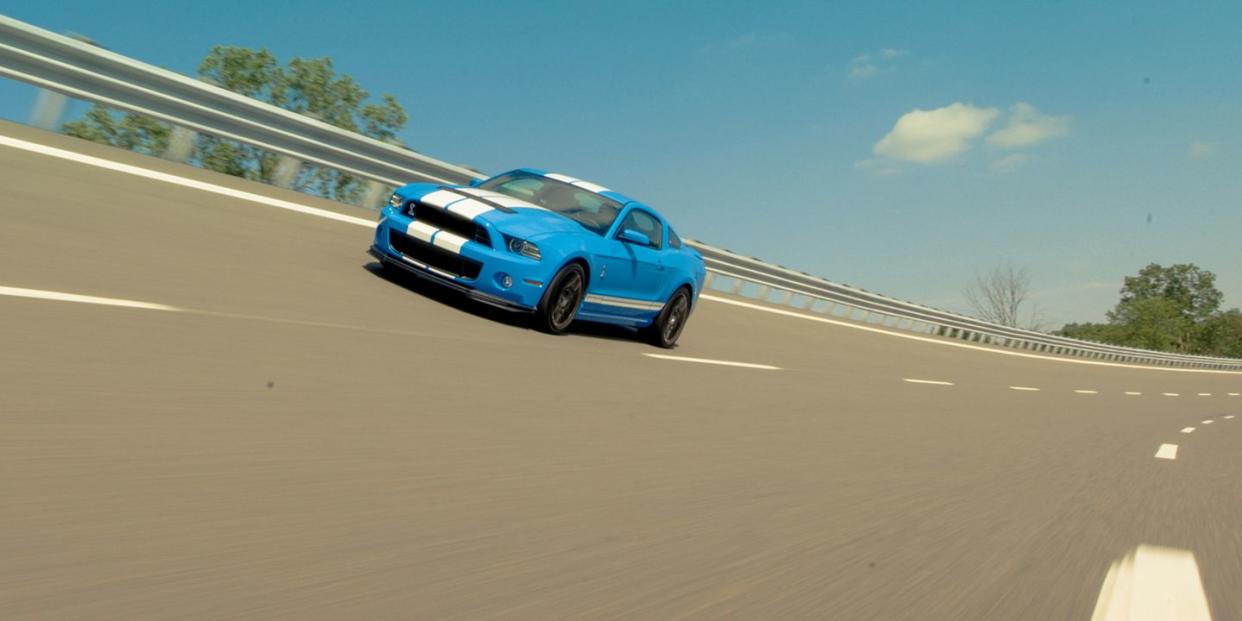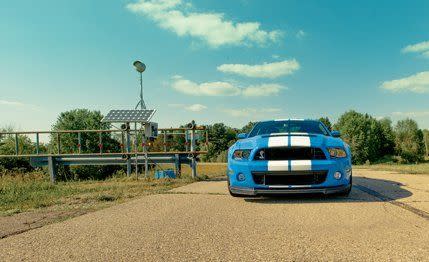We Gun for 200 mph in the 2013 Ford Mustang Shelby GT500


Nobody fusses too much over the top speeds of pony cars. Since the days of Jan and Dean, it’s been about short gearing, a stiff axle, and sticky rubber. Deliver a quarter-mile that drives ’em wild, and they will sign on the dotted line. The previous Shelby GT500 plowed into an electronic limiter at 155 mph, and nobody burned down the Glass House.
But this time Ford has dumped hi-test on the terminal-velocity discussion by claiming a 200-mph top speed for the 2013 GT500. In fact, 202 mph, supposedly observed on a test run at the circular, 7.8-mile Nardo Ring in southern Italy.
If so, the new GT500 would be the first factory Mustang to break into the 200-mph club. It also would represent a significant trickling down of speed capability. Suddenly, a $55,000 Mustang might take the working classes to where only plutocrats in their gilded, titanium-trussed exotics once ventured (some never to return).
The Shelby’s specs indicate that 200 was not an anomaly but a hunted target. For 2013, the standard rear-end ratio drops from 3.55 (3.73 with optional Performance pack) to 3.31, making the engine lug in top gear at any speed below 80 mph. But the ratio change—no doubt also to improve everyday fuel economy—puts the 200 mark in fifth gear, the one Ford says it used, at about 6400 rpm, or just below the engine’s power peak.

The prop shaft is made of carbon fiber to cut its weight and reduce sinusoidal vibration at the 8300 rpm it would turn at 200 mph, and drag-inducing wings are absent. The body is clad with just enough aero enhancements to create modest downforce above 150 mph, keeping the wheels on the ground.
Testing Ford’s claim created a venue challenge. Shipping our cast, crew, and a car to Italy would break the budget, while America deems going 200 mph on the street to be quite illegal, highly antisocial, and fraught with liability. And anyway, there is no such thing as a smooth public road at 200 mph. The smallest dip becomes a trench; the slightest bump, a launch ramp.
So we looked first at airfields. Ford figured we’d need at least 15,000 feet to hit the mark and also have room—maybe—to stop. That cut the airport options down to the few strips long enough to land the space shuttle, which touched down at about 220 mph. The Kennedy Space Center’s Shuttle Landing Facility on Merritt Island in central Florida’s Cape Canaveral is a spectacularly flat expanse that has been getting weedy since the end of the program.
After weeks of leaving unreturned messages, we finally located the appropriate NASA employee who is designated to give a somewhat shirty speech about how the strip was paid for by the taxpayers and is only available for rent (at $2575 per day with a six-day minimum contract) to research entities providing benefit to the taxpayer. And not, specifically, to “people who just want to go fast.” We offered to locate a few taxpayers who would vouch for the benefits of a 200-mph Mustang, but he hung up.
So did Vandenberg Air Force base in California, where an identical strip was built before the 1986 Challenger explosion ended plans for West Coast shuttle launches. The U.S. Army’s White Sands Missile Range has a vast gypsum playa that was used once to land Columbia in 1982 but has since fallen into disrepair. The Army was game for our test but said it couldn’t make the strip usable before our deadline.
With time running out, we settled on our old standby, the 4.7-mile oval at Chrysler’s proving ground in Chelsea, Michigan, a place where we’ve flogged many a supercar. A recent repaving smoothed it to autobahn perfection, but the oval’s 36-degree banking has a neutral speed—the speed at which no steering lock is required to corner—of only 130 mph. Thus, the considerably faster Shelby would be fighting lateral g’s through the oval’s banking and scrubbing off precious mph.
Still, with well over a mile of straightaway separating the turns, a solid measurement of the Shelby’s peak speed could be gauged as long as the driver kept his foot in it all the way around, which, as anyone who has entered a curve at more than 150 mph knows, takes some moxie.
The first runs were tentative, with the needle wavering at about 170 mph. Speed in modern cars can sometimes be remote and hard to judge, but not when on banking. As the Shelby tilted sideways, the road rose up in a black arc toward the top of the windshield. Just inches to the right was the streaking steel of the outside guardrail. Just to the left, the lane lines spat past in a fluttering blur. At 180 mph on banking, it feels like you’re doing 280 down the Death Star Trench. Your foot wavers on the gas pedal.

A lesser car would squirm in the banking as if chassis and body were held together with Slinky springs. But the GT500 felt as if tethered to the pavement by cables, so we were encouraged to go faster. With a slight northwesterly breeze at our backs, the Shelby exited Chelsea’s north banking at 185 mph with more than a mile of wide-open straightaway to eat up the final 15 mph. Our VBox’s digital speedo crawled up: 186, 187, 188, 188.1 . . .
It went for another 2 mph, and that’s all there was. We entered the south banking at just below 191 mph, our knuckles as white as Himalayan peaks. The top speed: 189 mph, an average of both directions.
How do we know that’s the limit? Well, our data recorder tells us that during the final 1500 feet, the Shelby averaged 0.004 g of longitudinal acceleration. At 190 mph, it was pulling 0.001 g, or, basically, zero. The car had stopped accelerating. [To confirm that the Shelby’s engine was up to snuff, we ran a chassis-dynamometer test.]

We also learned that a 15,000-foot runway would have been inadequate anyway. Had the acceleration curve remained constant when we came off the banking at 185 mph (it didn’t, it dropped to almost zero, but for academic discussion, let’s assume it did), the Shelby would have needed another two miles of straightaway to add the last 15 mph. So, three miles total. But on the oval, we entered that hypothetical three-mile run at 185 mph. On a runway, we would have started from a standstill and hit perhaps 180 mph by the end, with stopping left to the weeds.
We concede that a 2013 Shelby GT500 may have once hit 200 mph in some far-off land, perhaps with favorable winds. But we have no doubt that ours wouldn’t. Hey, Ford—invitations to Italy will be happily accepted.
You Might Also Like

